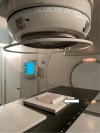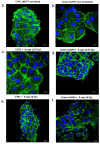Revolutionizing radiotherapy: gold nanoparticles with polyphenol coating as novel enhancers in breast cancer cells-an in vitro study
- PMID: 39812897
- PMCID: PMC11735827
- DOI: 10.1186/s11671-025-04186-x
Revolutionizing radiotherapy: gold nanoparticles with polyphenol coating as novel enhancers in breast cancer cells-an in vitro study
Abstract
Breast cancer is the most common cancer among women, with over 1 million new cases and around 400,000 deaths annually worldwide. This makes it a significant and costly global health challenge. Standard treatments like chemotherapy and radiotherapy, often used after mastectomy, show varying effectiveness based on the cancer subtype. Combining these treatments can improve outcomes, though radiotherapy faces limitations such as radiation resistance and low selectivity for malignant cells. Nanotechnologies, especially metallic nanoparticles (NPs), hold promise for enhancing radiotherapy. Gold nanoparticles (AuNPs) are particularly notable due to their high atomic number, which enhances radiation damage through the photoelectric effect. Studies shown that AuNPs can act as effective radiosensitizers, improving tumor damage during radiotherapy increasing the local radiation dose delivered. Traditional AuNPs synthesis methods involve harmful chemicals and extreme conditions, posing health risks. Green synthesis methods using plant extracts offer a safer and more environmentally friendly alternative. This study investigates the synthesis of AuNPs using Laurus nobilis leaf extract and their potential as radiosensitizers in breast carcinoma cell lines (MCF-7). These cells were exposed to varying doses of X-ray irradiation, and the study assessed cell viability, morphological changes and DNA damage. The results showed that green-synthesized AuNPs significantly enhanced the therapeutic effects of radiotherapy at lower radiation doses, indicating their potential as a valuable addition to breast cancer treatment.
© 2025. The Author(s).
Conflict of interest statement
Declarations. Competing interests: The authors declare no competing interests.
Figures










Similar articles
-
Anticancer activity of gold nanobioconjugates synthesized from Elephantopus scaber (linn.) leaf extract.J Cancer Res Ther. 2023 Apr;19(Supplement):S0. doi: 10.4103/jcrt.JCRT_1043_20. J Cancer Res Ther. 2023. PMID: 37147946
-
Breast radiotherapy with kilovoltage photons and gold nanoparticles as radiosensitizer: An in vitro study.Med Phys. 2022 Jan;49(1):568-578. doi: 10.1002/mp.15348. Epub 2021 Dec 1. Med Phys. 2022. PMID: 34778990 Free PMC article.
-
Photothermal therapy using folate conjugated gold nanoparticles enhances the effects of 6MV X-ray on mouth epidermal carcinoma cells.J Photochem Photobiol B. 2017 Jul;172:52-60. doi: 10.1016/j.jphotobiol.2017.05.012. Epub 2017 May 12. J Photochem Photobiol B. 2017. PMID: 28527427
-
Golden era of radiosensitizers.Front Vet Sci. 2024 Dec 6;11:1450776. doi: 10.3389/fvets.2024.1450776. eCollection 2024. Front Vet Sci. 2024. PMID: 39711799 Free PMC article.
-
Green Synthesis of Gold Nanoparticles Using Plant Extracts as Beneficial Prospect for Cancer Theranostics.Molecules. 2021 Oct 22;26(21):6389. doi: 10.3390/molecules26216389. Molecules. 2021. PMID: 34770796 Free PMC article. Review.
References
-
- Ghoncheh M, Pournamdar Z, Salehiniya H. Incidence and mortality and epidemiology of breast cancer in the world. Asian Pac J Cancer Prev. 2016;17(sup3):43–6. 10.7314/APJCP.2016.17.S3.43. - PubMed
-
- Bartsch R, et al. Ovarian function suppression and fulvestrant as endocrine therapy in premenopausal women with metastatic breast cancer. Eur J Cancer. 2012;48(13):1932–8. 10.1016/j.ejca.2012.03.002. - PubMed
-
- Chan A, et al. Neratinib after trastuzumab-based adjuvant therapy in patients with HER2-positive breast cancer (ExteNET): a multicentre, randomised, double-blind, placebo-controlled, phase 3 trial. Lancet Oncol. 2016;17(3):367–77. 10.1016/S1470-2045(15)00551-3. - PubMed
LinkOut - more resources
Full Text Sources
